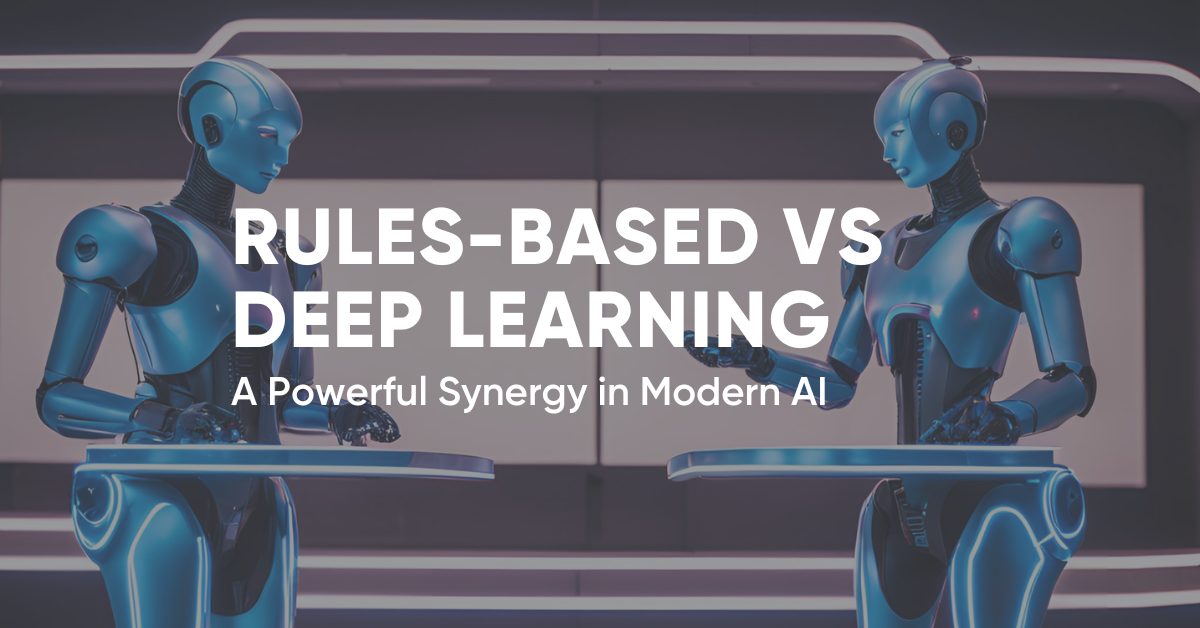Artificial intelligence (AI) is revolutionizing industries worldwide, with computer vision and generative AI at the forefront of this transformation. Two fundamental approaches within AI, rules-based systems and deep learning, each offer unique strengths. Increasingly, the most powerful solutions arise from fusing these approaches, leveraging the transparency of rules-based systems and the adaptability of deep learning. This synergy is setting a new standard for accuracy and trust in AI applications.
Rules-based Systems: The Foundation of Logic
Rules-based systems, also known as expert systems, operate on predefined rules and logic, mimicking human reasoning. These rules, often designed by domain experts, guide the system’s decision-making process.
Strengths:
- Transparency and Explainability: Rules-based systems provide clear explanations for their decisions, tracing back to specific rules. This transparency is vital in applications where accountability and trust are paramount, such as medical diagnosis or financial fraud detection.
- Control and Predictability: Adhering strictly to predefined rules ensures predictable and controlled behavior. This is crucial in applications requiring strict compliance with regulations or guidelines, like autonomous vehicles and industrial automation.
- Easy to Implement and Maintain: Developing and maintaining rules-based systems can be relatively straightforward, especially for well-defined tasks. Updating the system often involves simply modifying the rules.
Weaknesses:
- Limited Adaptability: Rules-based systems struggle with situations outside the scope of predefined rules, hindering their ability to adapt to new data or changing environments.
- Difficulty Handling Complexity: As problem complexity increases, the number of rules required can become overwhelming, making the system difficult to manage.
- Susceptibility to Bias: Rules created by humans can reflect their biases, potentially leading to unfair or discriminatory outcomes.
Deep Learning: The Power of Data
Deep learning, a subfield of machine learning, utilizes artificial neural networks to analyze data and learn complex patterns. These networks, inspired by the human brain, are trained on massive datasets to recognize intricate relationships and make accurate predictions.
Strengths:
- Adaptability and Learning: Deep learning models excel at learning from vast amounts of data and adapting to new information, making them ideal for dynamic environments and complex tasks.
- Handling Complexity: Deep learning thrives on handling unstructured data like images, audio, and text, enabling solutions for tasks like image recognition and natural language processing.
- High Accuracy: Deep learning models often achieve state-of-the-art accuracy, surpassing human capabilities in specific tasks.
Weaknesses & Mitigations:
- Black Box Problem: The decision-making process of deep learning models can be opaque, making it difficult to understand why a particular decision was made. This can be mitigated by having MLOps track the efficacy of models.
- Data Dependency: In the past, it was believed that training deep learning models required massive labeled datasets, which can be expensive and time-consuming to acquire. Not only are these datasets now easier to acquire, but companies like ClearObject are able to build highly accurate models for business use cases with less data.
- Computational Resources: More and more a weakness of the past, training deep learning models demanded significant computational power and time. Today, tools such as the highly efficient ClearVision Inference Engine slash the requirements for both power and time.
The Fusion: Combining Strengths for Superior Performance
The true power of AI is unleashed when we combine the strengths of rules-based systems and deep learning. This fusion allows us to leverage the adaptability of deep learning while maintaining the transparency and control offered by rules-based systems.
In computer vision, this fusion is revolutionizing applications across industries:
- Medical Imaging: Deep learning models can analyze medical images to detect anomalies, while rules-based systems can incorporate medical knowledge and guidelines to ensure accurate and reliable diagnoses.
- Autonomous Vehicles: Deep learning enables vehicles to perceive their surroundings, while rules-based systems enforce traffic laws and safety regulations.
- Manufacturing Quality Control: Deep learning models can identify defects in products, while rules-based systems can ensure compliance with quality standards and industry regulations.
This fusion not only delivers unparalleled accuracy but also fosters trust in AI systems. By incorporating rules and logic, we can ensure that AI decisions are aligned with human values and ethical considerations.
Rules-based systems and deep learning need not be competing approaches, they can be complementary tools in the AI toolkit. By fusing their strengths, we can create AI solutions that are both powerful and trustworthy. This synergy is driving innovation across industries, setting a new standard for performance and reliability in computer vision and beyond. As AI continues to evolve, the fusion of rules-based systems and deep learning will be crucial in unlocking its full potential and shaping a future where AI benefits humanity in meaningful and responsible ways.
Experts like ClearObject can help
At ClearObject, we are experts in bleeding edge Vision models, which are more flexible to train. By using the latest in GenAI models in process training, we are rating highly performant edge-ready models in record time, and can deploy these models for a wide variety of use cases with additional post-processing capabilities.
Which approach is right for you? Chat with our experts.

